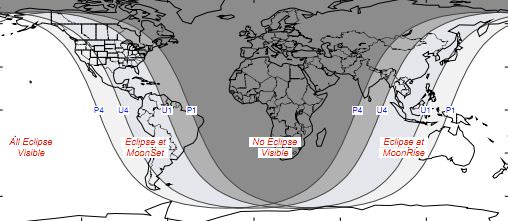[/caption]
What with solar flares, sunspots and an annular solar eclipse, the Sun has been the centre of everyone’s attention lately. Next week all eyes (suitably protected, I trust) will be turned Sun-ward again to watch the last transit of Venus this century. Not to be outshone, the full Moon is preparing a little show of its own on Monday June 4th as a curtain raiser for the transit on the following day. Here is the what, when and where, of the first lunar eclipse of 2012:
During the new Moon on May 20th an annular solar eclipse was produced when the Moon got between Earth and the Sun. This time a partial lunar eclipse will occur when the Earth is positioned between the full Moon and the Sun and Earth’s shadow will be cast across part of the Moon’s surface. Unlike a solar eclipse no special protective eyewear is necessary, and a pair of binoculars will show it to its best advantage. The eclipse occurs at the Moon’s ascending node in southern Ophiuchus just northeast of Antares, and will be visible at Moonrise from Australia and East Asia, with the entire eclipse visible across the Pacific, while much of North and South America will see the eclipse as the Moon sets.

The other nice thing about lunar eclipses is that they last much longer than a solar eclipse. The penumbral phase, when the Moon passes through the outer portion of Earth’s shadow, causing only subtle darkening of the Moon, will last four and a half hours and partial phase, when it passes through our inner, umbral shadow, will last for 2 hours and 6 minutes. Penumbral eclipse begins 08:48 UTC and partial eclipse at 09:59 UTC. Greatest eclipse is at 11:03 UTC when it will be directly over the South pacific. During greatest eclipse the maximum umbral magnitude will be 0.38 as the southern limb of the Moon will dip 12.3 arc-minutes into the umbra and the area around the crater Tycho will be in shadow and take on a rosy glow due to the refraction of sunlight through Earth’s atmosphere. This is only appropriate as the full Moon in June is named the Strawberry Moon in native American folklore and the Rose Moon in Europe. The colour the Moon turns during greatest eclipse depends on how much dust and clouds are present in the atmosphere and can range from dark brown and red to bright orange and yellow. Partial eclipse will finish at 12:06 UTC and penumbral eclipse will end at 13:18 UTC.
If you are not lucky enough to be on the right side of the planet (like Europe, Africa, New England and eastern Canada) then the good folks at SLOOH will be webcasting the event live. There will be another lunar eclipse in November but that will only be penumbral, which are not very noticeable, just a slight dimming, so make the most of the Moonshow on Monday as a warm up for the star attraction the next day!
Find out more about the eclipse at EarthSky
and timeanddate.com


Awesome. Europe has really drawn the wrong card this year: No solar eclipse, no Venus transit, and also no lunar eclipse. Great.
I know! It’s like the whole Solar System is against us : (
Unless you are in Portugal or Spain, the transit of Venus IS VISIBLE from all over Europe. Not the perfect opportunity indeed, but better than nothing!
Is that so? Then I was wrong. Still. I’m quite sure it will NOT be visible….. if the weather outlook continues to be like it is right now, that is.
Try being in South Africa. We are not getting any of the good stuff this time round. Except for half a SKA.